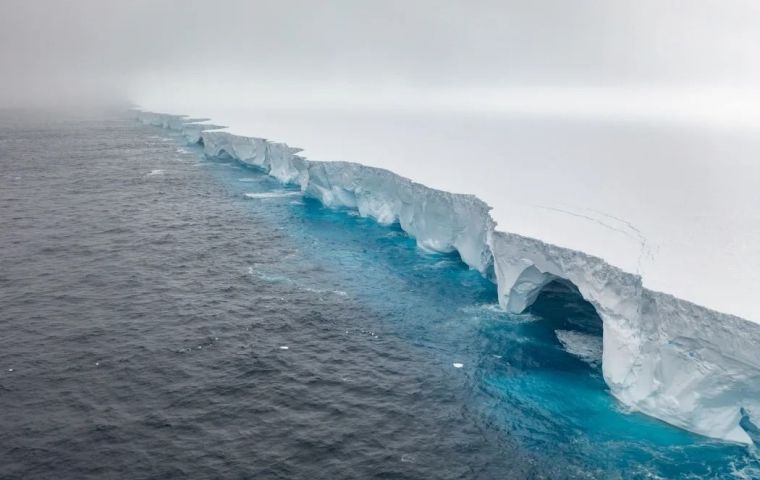MercoPress. South Atlantic News Agency
Giant iceberg approaching South Georgia stirs fears
 A23a was confirmed to be intact and 173 miles from South Georgia
A23a was confirmed to be intact and 173 miles from South Georgia A23a, arguably the world’s largest and oldest iceberg which has been wandering through the South Atlantic and headed for the British Overseas Territory of the South Georgia Islands since last month, has been reported not to have changed course this week nor upped nor melted, thus posing a serious threat to the local fauna. Earlier this week, it was spotted 173 miles (280km) away.
The iceberg could ground against the island, meaning that the many seals and penguins living there could be unable to access food. In 2004, the A38 iceberg grounded on South Georgia's continental shelf, leaving dead penguin chicks and seal pups.
The ice mass is estimated to weigh nearly a trillion tons. The South Georgia and the South Sandwich Islands have a rich biodiversity and are home to one of the world's largest Marine Protected Areas. According to satellite images, it appears to have maintained its structure and is yet to break up into smaller chunks, the British Antarctic Survey (BAS) explained. Thousands of smaller icebergs are harder to track and just as hazardous, sea captain Simon Wallace said from South Georgia. “The smaller ice can gather in strips and patches and depending on their density can be impassable as well as filling the bays and fjords of South Georgia making them inaccessible to us, which can really be an issue,” he also explained. “Icebergs are inherently dangerous. I would be extraordinarily happy if it just completely missed us,” he added.
The US National Ice Center confirmed earlier this month that A23a remained the largest in the world, spanning an area of 3,672 square kilometers back in August. A23a has held the title of the “largest current iceberg” multiple times since the 1980s, though it has been surpassed on occasion by larger but shorter-lived icebergs, like A68 in 2017 and A76 in 2021. Giant icebergs are expected to be a common feature shortly given the warmer waters now surrounding Antarctica, due to which more ice chunks will most likely calve.
The structure has been closely monitored since it broke off from the Filchner-Ronne ice shelf in 1986, after which it remained grounded on the Antarctic’s Weddell Sea floor for more than 30 years. Then, it was carried away before it became stuck again in a Taylor column, a spinning vortex of water caused by ocean currents hitting an underwater mountain. It previously hosted a Soviet research station.
“It is presently in a meander of the current and not moving directly towards the island,” BAS oceanographer Andrew Meijers pointed out. “But our understanding of the currents suggests that it is likely to again move towards the island soon.“ Meijers insisted that satellite images showed A23a was intact, unlike previous “megabergs,” which disintegrated into smaller pieces.
”South Georgia sits in iceberg alley so impacts are to be expected for both fisheries and wildlife, and both have a great capacity to adapt,“ Mark Belchier, a marine ecologist who advises the South Georgia government, was quoted as saying.
”People might be worried that it's likely to come into contact with South Georgia in the next two or four weeks. South Georgia is home to fur seals and penguins, and currently, they're in the middle of their breeding,“ Meijers said. Millions of seals, penguins, and seabirds breed on South Georgia and forage in the surrounding waters. ”So if it grounds, it will disrupt their access to food supplies, which means a lot of the chicks and pups are likely to die. That’s on top of a bad season already, because bird flu is affecting seals and penguins in the region,” he added.
In 2020, iceberg A68 stirred fears that it would collide with South Georgia and crush marine life on the sea floor. But it eventually broke into smaller chunks.




Top Comments
Disclaimer & comment rulesCommenting for this story is now closed.
If you have a Facebook account, become a fan and comment on our Facebook Page!